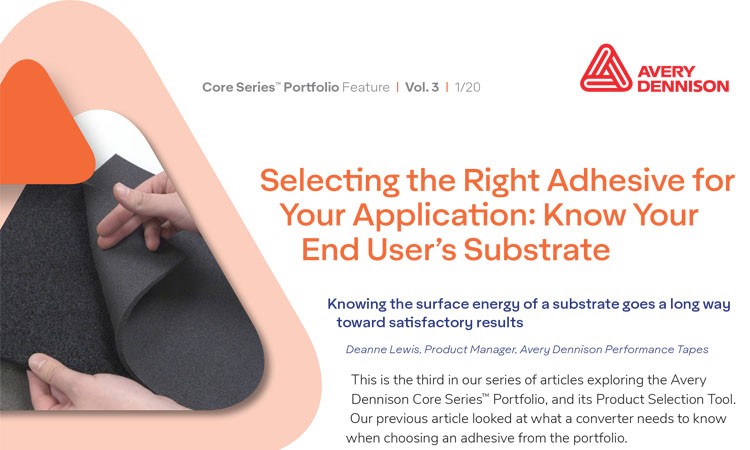This is the third in our series of articles exploring the Avery Dennison Core SeriesTM Portfolio, and its Product Selection Tool. Our previous article looked at what a converter needs to know when choosing an adhesive from the portfolio.
In this article, we move ahead to thinking about the substrate the customer/end user will adhere to, and what information the converter should have on hand when choosing that adhesive. I spoke to my colleague, Scott Krusinski, application engineer, who shared some of his knowledge on this step in the process.
Deanne Lewis (DL): What does the converter need to know about the substrate the end user is going to adhere to?
Scott Krusinski (SK): The most important item to know is whether it’s categorized as high, medium, or low surface energy. We talked about this in the last article about lamination, and it applies here as well. Converters should be sure to ask their customers about this characteristic of the substrate.
A given adhesive is optimized for a certain surface energy, so the converter needs to make a compatible choice. High surface energy substrates, such as metals, are pretty easy to bond to. Lower surface energy substrates, such as EVA or polypropylene plastics, are a little more tricky. The good news is the adhesives in the Core Series Portfolio cover the full spectrum.
DL: Can you explain what surface energy is?
SK: Surface energy is a characteristic of a substrate that affects how it interacts with adhesives, including adhesives. A low surface energy will reduce an adhesive’s ability to “wet out,” making bonding more difficult. A high surface energy enables the wet out, and thus is easier to bond.
Anyone who’s detailed a car is probably familiar with surface energy. Think of how water beads on a waxed hood, compared to how it spreads over an unwaxed hood. That spreading is an example of wet-out. That’s low versus high surface energy.
It’s not important for converters to understand the science behind surface energy. But I think it is important to understand, generally, what surface energy is. Industries are using more low surface energy materials while they grow their use of pressure-sensitive adhesives. Converters need to be aware of this, and make sure they’re choosing adhesives appropriately.
DL: So what are the surface energies of the most common industrial substrates?
SK: These are the most common:
High:
|
Aluminum, Stainless Steel, Copper, Glass, Polyimide (Kapton®), Nylon, Polyester, (PET) Film, Polyurethane Film
|
Medium:
|
ABS, Polycarbonate, Vinyl (PVC), Acrylic, Polystyrene
|
Low:
|
EVA, Powder Coated Paint, Polyethylene, Polypropylene, PVF
|
Extra low:
|
PTFE (Teflon™), Silicone
|
Our Core Series Portfolio Product Selection Tool has this chart as well. Once again, converters should be sure to ask their customers what the construction will be adhered to, then use the chart in the tool to make an appropriate adhesive selection.
DDL: The good news is that they have access to adhesives optimized for these diverse applications. And they have a tool—our Core Series Portfolio—to help them get those adhesives.
SK: That’s correct. And if they have any questions or need any help with a substrate not addressed in the portfolio, converters can contact their Avery Dennison account manager, or contact our Application Support Line (1-866-462-8379, or core.series@averydennison.com).
The Core Series™ Portfolio is designed to make it easy for you to do business with Avery Dennison and your customers. A streamlined portfolio of 32 pressure-sensitive adhesive products, the offering covers a large percentage of bonding and application solutions. For more information visit, www.tapes.averydennison.com/coreseries.

